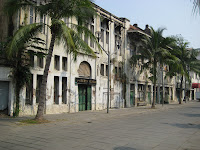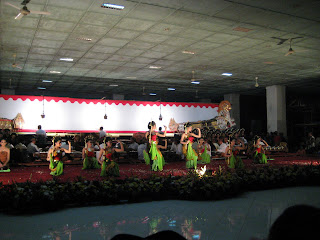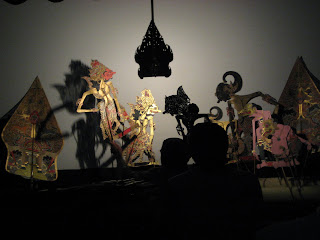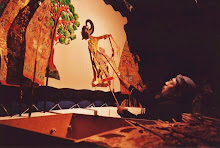Jakarta, a city of swirling, chaotic movement, full of smog, cars and motorcycles in massive amounts. A city rich and poor, beautiful and ugly, new and old, of opposites, everywhere you look.

I ventured out early to the Wayang Museum (Puppetry Museum) which happened to be rather far from my hotel. Swarms of motorcycles and scooters whiz by with children and/or goods strapped on to the back. The bikes swerve in and out of traffic and honking happens just about every other minute on the road. My taxi driver stops at the end of a road blocked off to cars and tells me the museum is at the end. I get off wearily, since it looks pretty abandoned and in disrepair, but he assures me that this is where the museum is and that it is closed to cars because there are various museums in the area and it is only for pedestrians.

I get off and begin to walk down this street being very aware of what and who is around me. Many of the buildings are crumbling, perhaps from a previous earthquake and were never repaired. I am the only person walking down this pedestrian street. At the end I see some movement, but cannot be sure what is going on. As I get closer I realize this opens to a plaza on the right that is flanked by museums on all sides. The buildings are all old Dutch buildings. I see a photographer with a model taking pictures with various assistants, they look rather professional and further down I see what looks like a low grade film crew, filming some type of movie and the Wayang Museum in a nicely kept building with no signage.

The building is dimly lit, the entrance fee, 2,000 rupiah which is roughly 20 cents. A serious, almost mean looking woman takes my money and tells me to come get my change later because she doesn't have enough to break my 50,000rp bill (a little more than $5). By the way, people here are very nice, polite and smiles come easily and frequently. Its almost weird and foreign for me to smile and say hello to people so much, especially coming from New York City where my smile or greetings would be a nuisance in a place where people want to be left alone. So a young man proceeds to give me a tour and tell me how beautiful I am.

He insists that I look like an American moviestar. We tour the museum which is actually quite small, dark and musty. The displays do not look well kept, but the puppets are absolutely magnificent and they have puppets from all over Indonesia and some from other parts of the world as well.


Some puppets from the mid-late 1800's and some bejeweled with rubies and sapphires. He talks to me about the different characters from the epic Hindu stories of the Ramayana and the Mahabharata and how in Indonesia they have adapted the stories to fit their culture. He shows me the Indonesian superman. A mustached blue mythical character with superpowers that he claims must have inspired superman's creator.

I agree. Its obvious that these characters are part of the human psyche and have been recycled throughout time. He then tries to sell me some puppets, but I hold off since when I get to Solo I will be going to the actual puppet makers workshops and would rather buy directly from them. His student, a young woman, tells me again how beautiful I am and that I look like Jennifer Connelly. She says she watches a lot of American films. They agree that I am a Connelly look a like. I agree with a bright smile, its the polite thing to do. I then walk around the plaza. Buy some cigarettes for $1 (big change from the $9 in NY...who can afford to smoke in NYC anymore) and a water for 25 cents and sit in the square where a man waves at me, a little girl not very shy sits across from me, looking and smiling at me. A trio of teenagers on their way to one of the museums asks to take a picture, I think they are asking me to take a picture of them, but no, they want pictures with me! Crossing the street here is a dangerous adventure. There are crosswalks but no lights and cars and motorcycles speed by. I stand there for quite a while waiting for an appropriate moment, but none come and others cross by barely getting through. I take a risk...woah! made it! What is across the street that I would risk my life for? Another museum. Of what, I'm not sure since I can't read Indonesian, but it turns out to be a fine art museum...again, dark and musty but with beautiful Indonesian art. I risk my life one more time crossing the street and go to a cafe in the plaza called Cafe Batavia. It is old world colonial looking. It is a beautiful restaurant cafe serving expensive coffee, drinks and Chinese food. Strange combination. Mid-day there are many tourists here all just sitting around in the bar area sipping coffees. I head back to the hotel after having a cappuccino, not very Indonesian of me. For lunch I have Indonesian oxtail soup (rabo encendido!) served with rice and a little plate of hot chili which I proceed to dump into my soup...delicious! And then the jet lag sets in. 3 o'clock I am dead tired, pass out and wake up at 9pm, forced myself back to sleep in an attempt to get myself into this time zone.
 This picture is special for Lauren, Lore and Liz - good jumping spot! wish you were here!
This picture is special for Lauren, Lore and Liz - good jumping spot! wish you were here! Mt. Lawu looms in the distance.
Mt. Lawu looms in the distance. Coffee plantations line the slopes and hills up Mt. Lawu
Coffee plantations line the slopes and hills up Mt. Lawu The Cetho Temple after going through the successive gateways. It is about 1 story high. The temple being at the back of the site is in the East Java style, the Central Java temples of Borobudur and Pramadan built earlier have the temple in the center. The style is reminiscent of the ancient Maya and Aztec temples of Central America although there is no evidence of contact between these cultures.
The Cetho Temple after going through the successive gateways. It is about 1 story high. The temple being at the back of the site is in the East Java style, the Central Java temples of Borobudur and Pramadan built earlier have the temple in the center. The style is reminiscent of the ancient Maya and Aztec temples of Central America although there is no evidence of contact between these cultures. View from the temple steps leading to top out to the various descending levels and gateways.
View from the temple steps leading to top out to the various descending levels and gateways. Sukuh Temple is also built with various levels that ascend towards the temple but has only one gateway that looks more like a mini temple and fertility rites would be performed there.
Sukuh Temple is also built with various levels that ascend towards the temple but has only one gateway that looks more like a mini temple and fertility rites would be performed there.

































